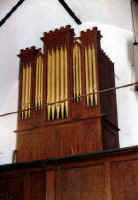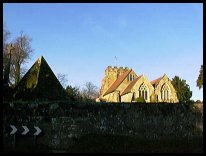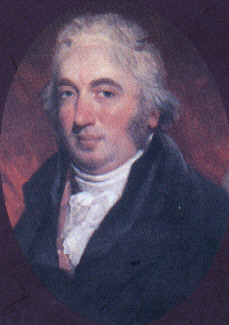|

In 1820 Fuller commissioned W A A. Nicholls to make the barrel organ, which is the largest of its kind in Britain still in full working order. This replaced an earlier organ which went to New Zealand and was preserved in a museum. A gallery to support it was also funded by Fuller.
This magnificent instrument has six stops with two barrels each playing twelve tunes. A printed label at the back of the chest reads:
'W.A.A.Nicholls, son-in-law and successor to the late G.P. England,
No.9 Stephen Street, Tottenham Ct. Rd.'
"When the organ was first installed Fuller presented the male members of the choir with white smocks, buckskin breeches and yellow stockings and the females with red cloaks to be worn on the day the organ was first played and afterwards."
[MacDermott -
The firm of Harrison & Harrison did restoration work on the organ in 1960 and 1964. The organ was more recently restored in 1999 by Stuart Stobbs and Domenic Gwynn of the firm
Martin Goetze and Dominic Gwynn, Worksop, Nottinghamshire.
|
|
|
The British Institute of Organ Studies granted the organ at St. Thomas of Canterbury [N15468] an Historic Organs Certificate (Ungraded),
which was awarded in 1999:
Swell to Great
Swell to Pedal
Swell Octave
Swell Suboctave
Great to Pedal
.
|
Key action
|
Stop action
|
Compass low
|
Compass high
|
Notes
|
Enclosed
|
Pedal
Great
Swell |
|
|
C |
f1 |
30 |
N
N
Y |
Department
|
Stop Name
|
Pitch
|
|
Pedal |
1 Bourdon |
16 |
Department
|
Stop Name
|
Pitch
|
| Great |
2 Open Diapason |
8 |
| |
3 Stopped Diapason |
8 |
| |
4 Dulciana |
8 |
| |
5 Principal |
8 |
Department
|
Stop Name
|
Pitch
|
| Swell |
6 Clarabella |
8 |
| |
7 Vox Angelica |
8 |
| |
8 Gemshorn |
4 |
| |
10 Tremulant |
8 |
|
|
For further details of the refurbished organ, link
here.
"In preparation for a visit by the bishop Fuller refurbished the interior of the church by boxing in and plastering the walls of the nave and chancel and painting them with whitewash. Unfortunately, in his enthusiasm, he painted over some of the
extremely rare wall paintings which adorned the church. They were rediscovered in 1966."
[Geoff Hutchinson, Fuller of Sussex: A Georgian
Squire (Hastings, Sussex: M & W Morgan, 1993, revised 1997) ISBN 0-9519936-6-6]
|



